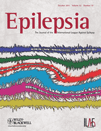Perilesional gliosis around solitary cerebral parenchymal cysticerci and long-term seizure outcome: A prospective study using serial magnetization transfer imaging
Necessary approval was secured for this study from the Institutional Ethics Committee.
Summary
Purpose: Epilepsy following solitary cerebral cysticercosis (SCC) is possibly caused by perilesional gliosis, best visualized on magnetization transfer imaging (MTI).This study aims to describe development of gliosis around SCC by prospective serial MTI and to correlate this gliosis with long-term seizure outcome.
Methods: We randomized 123 patients with SCC and new-onset seizures to treatment with albendazole plus antiepileptics (treatment), or antiepileptics only (control), and performed magnetic resonance imaging (MRI) scans at 0, 3, 6, 12, and 24 months. Prospective follow-up data regarding seizure outcome up to 5 years later were collected. MRI studies were analyzed for lesion characteristics and perilesional magnetization transfer (MT) hyperintensity.
Key Findings: Clinical and radiologic data of 77 patients were analyzed. Demographic and seizure characteristics were similar in treatment and control groups. Clinical data were available up to 64 months after enrollment. At 12 months, 89.5% patients were seizure-free. MTI is more sensitive than routine imaging for detection of perilesional gliosis. Albendazole treatment did not affect imaging or clinical outcome, including development of gliosis. Independent of duration of follow-up, gliosis was associated with more seizures, and with seizure recurrence at 12 months; duration of seizures and antiepileptic therapy was longer. Gliosis was not dependent on seizure type or stage of degeneration at enrollment or persistence/calcification of the lesion.
Significance: Perilesional gliosis around SCC helps prognosticate seizure outcome. Poorer outcome in patients with persistent lesions is likely to be related to mechanisms other than gliosis. The lack of effect of albendazole on seizure outcome may be due to its inability to decrease formation of gliosis.




